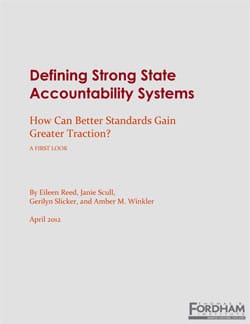As of April 5, 2012, forty-five states plus the District of Columbia had adopted the Common Core State Standards (CCSS). While they deserve plaudits for strengthening their previously lackluster expectations for students, nobody should expect standards-adoption alone to drive academic gains. Nor will the development of curriculum, adoption of new textbooks, and ramped up professional development—some of the “stuff” that folks refer to when they talk about “implementing” the CCSS—mean much unless accompanied by means of holding individuals and buildings accountable for progress. To get real traction from new standards, states must also install robust accountability systems that incentivize, support, reward, and sanction districts, schools, students, teachers, and other adults.
This is the perfect time for states to reboot their accountability systems, not only because of the opportunity presented by CCSS, but also due to the availability of waivers from some of the accountability shackles and oddities of No Child Left Behind. Moreover, most of the ESEA reauthorization bills now creaking through Congress would give states even wider latitude to design their own approaches to accountability.
But what do strong state accountability systems look like? And how strong are they today?
 The time is ripe for states to revamp their approaches to accountability. |
To examine those questions, Fordham probed the accountability systems of seven states as part of our new pilot study, “Defining Strong State Accountability Systems: How Can Better Standards Gain Greater Traction?” Our investigation revealed three key strengths in their present accountability systems and three worrisome weaknesses. First, the strengths:
1. Several states have developed clear and comprehensive means for rating district and school performance. Robust accountability systems turn multiple data points into user-friendly labels. For instance, Florida and (more recently) Indiana use A-to-F grades to denote performance. These identifiers are informed by a basket of achievement measures, including student proficiency and growth—but also by such other indicators as graduation rates, attendance, AP/IB course-taking, achievement gaps, and performance on college entrance tests.
2. States are collecting more and better data and making progress toward user-friendliness. Well-functioning accountability systems provide data on state, district, school, and student performance to help educators, parents, and taxpayers understand and evaluate school results. Making these data user-friendly is a continuing challenge, but states such as Ohio are making strides. In addition to its school report card, Ohio also issues a web-based interactive Local Report Card (iLRC) that allows easy comparison among schools and districts.
3. Teacher accountability is improving. More states, such as Florida, Indiana, and Colorado, are incorporating student achievement measures into teacher evaluations, which then (sometimes) inform employment decisions. More states are also questioning automatic tenure after two or three years and experimenting with performance-pay options.
Now, the weaknesses:
1. States still struggle to meld their own accountability systems with federal requirements. Since enactment of NCLB, they’ve tried to integrate state and federal requirements so as to avoid conflicting messages. The ESEA waivers will likely help but so far few jurisdictions have managed this synthesis. Massachusetts, for example, has designed a unified system that allows it to report one marker of school performance based on both state and federal measures, and to set individual-group improvement targets that also meet federal requirements for each school and district.
2. Few states employ strong incentives to drive school, district, principal, and student performance. Many have policies that seek to intervene in instances of weak performance but few incentivize or reward superior performers. Recent budget reductions have diminished such incentives for schools, teachers, and principals. States do a tad better rewarding students; a couple of them offer high flyers automatic college admission or financial aid.
3. Sanctions are non-existent or ineffective. Transparent data must be coupled with meaningful actions that address low performance. Previous research has shown that NCLB’s cascade of interventions was unsuccessful, in part because districts took the road of least resistance. Of course, the federal School Improvement Grants (SIG) are intended to address this problem, but many districts are struggling to remove ineffective teachers and recruit high-quality leaders. If school sanctions such as replacement of staff, building closures, and charter conversions—and student sanctions such as “third-grade reading guarantees” and “no pass, no play” policies—are to succeed we need courageous leaders willing to champion them and meaningful incentives that reward such behavior.
The insights drawn from those in-depth analyses led us to posit that strong state accountability systems share six essential elements:
On reflection, developing and adopting the Common Core was the easy part.
- Challenging, clear, and specific standards in all core content areas, and rigorous assessment of those standards;
- Accessible, actionable data, including summative outcome information as well as formative data to drive continuous improvement;
- Annual designations for each school and district that differentiate—and underscore–their performance;
- Rewards and consequences to drive improvement at the school and district levels;
- Rewards and consequences to drive improvement at the individual student level; and
- Rewards and consequences to drive improvement at the teacher and administrator level.
With all six elements in place, policymakers will boost the odds that their schools will deliver more learning and that their students will absorb it.
On reflection, developing and adopting the Common Core was the easy part. Developing aligned and rigorous assessments is trickier—and the consortia now working on that project have so far revealed very little about their progress. Yet accountability remains the greatest challenge because few people relish playing tough and elected officials who do so almost never get thanked. While waivers and the Common Core represent a golden opportunity to improve the odds for kids, without that commitment to doing the dirty work of holding everyone in education accountable, the first two steps may prove fruitless.
Will states make the most of the opportunities before them? Or will they recoil and renege on their responsibility to students, parents, and communities? We at Fordham will follow this unfolding story over the next several years and let you decide.
